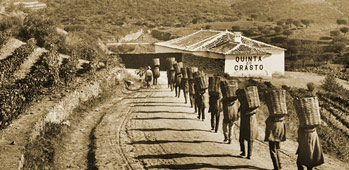
The latest edition of Precedent is out, and inside you’ll find the Short Cellar’s guide to the tricky art of navigating your way around a wine list. One of the most important tips that I mention is to hunt for bottles from underrated regions where the price tag has not yet caught up to the quality of the wine. The days when good value could be had from California are now the stuff of legends, but there are still some places where the dream of a true bargain lives on.
Take the example of Crasto 2006 ($15.00 [Ed. note: 2006 is no longer available], Vintages #81588) from Quinta do Crasto in Portugal. It is a drop-dead gorgeous red wine. The nose is big with idiosyncratic flavours of blueberries, fennel seed and cedar. Tasting it, it has a plush raspberry fruitiness that non-connoisseurs will enjoy (like the Fuzion I reviewed earlier). But unlike most inexpensive bottles, it has the concentration, depth and tannic structure that critics appreciate. As a result, it has a luxurious mouth-feel today and the capability to keep on evolving if it’s cellared for a few more years. At $15, you should stop reading this article and run to the liquor store. Push people down if they get in your way.
Portugal is my favourite place to find cheap red wine that tastes like expensive red wine. It was not always like this. Portugal used to be famous for cheap red wine that tasted like sepsis. Take the example of port, Portugual’s legendary fortified wine. Port started out as regular table wine that was so bad that the only people who would drink it were the English, and the only way to keep it from turning to vinegar during transport was to stabilize it with brandy. Somehow, this gastronomical disaster turned into one of the world’s great sweet wines. Unfortunately, the table wines stayed raunchy until Portugal joined the EU and the wine making industry modernized. Since then, quality has improved dramatically, but marketing is still somewhere in the Stone Age, which keeps prices low.
Interestingly, Crasto comes from the Douro Valley, the same region that makes Port. The vineyards are plowed out of steep mountainsides, where the vines live on a perfect diet of blistering sun and minerals gathered from the flinty schist, which gives the grapes complexity and power. There was a time when the best grapes went to making port, but this is now changing. If you are hunting for a bargain the next time you find yourself with a wine list in your hands, just look for a red from Douro. Bargain hunting has never been so much fun.
Matthew Sullivan is a lawyer with the Department of Justice in Toronto. He writes a weekly blog entry here on lawandstyle.ca. The Short Cellar column appears in the print edition of Precedent. Matthew can be reached at matthew@lawandstyle.beta-site.ca

